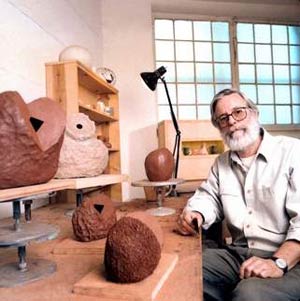
 Sculpture News at SculptSite.com
Sculpture News at SculptSite.com
Ken Price Sculpture |
 Ken Price works in his studio in Venice, Calif., in 1992. New York Times News Service |
| bendbulletin.com By Christopher Knight / Los Angeles Times Kenneth Price, a prolific Los Angeles artist whose work with glazed and painted clay transformed traditional ceramics while also expanding orthodox definitions of American and European sculpture, died Friday at his home and studio in Taos, N.M. He was 77. Price had struggled with tongue and throat cancer for several years, his food intake restricted to liquids supplied through a feeding tube. Despite his infirmity, he continued to produce challenging new work and to mount critically acclaimed exhibitions at galleries in Los Angeles, New York and Europe. In the decades following World War II, Price was among the first generation of iconoclastic L.A. artists to attain international stature. Three Price sculptures were on view in "Pacific Standard Time: Crosscurrents in L.A. Painting and Sculpture, 1950-1970," a survey of 47 leading postwar artists that closed this month at the J. Paul Getty Museum. Important examples of his work are currently included in three additional museum shows featured as part of the Getty-sponsored Pacific Standard Time, which chronicles significant aspects of Los Angeles art made during the city's efflorescence between World War II and 1980. Price's work is often erroneously described as having "transcended" ceramics to become sculpture. However, his organic and geometric forms, use of vibrant colors and provocative installation motifs instead speak of a thorough knowledge and embrace of critical aspects of ceramic history and its shifting place in art's continuum. Price's exquisitely crafted art, often leavened by erotic wit, simply accepted clay's sculptural bona fides. "Price's practice has remained resolutely original, challenging categorization and redefining contemporary sculpture," said Stephanie Barron, senior curator of modern art at LACMA and organizer of the Price retrospective. "The observation that critic Lucy Lippard made in 1966 seems prescient: 'It is a fact rather than a value judgment that no one else on the East or West Coast is working like Kenneth Price.'" Especially important to his work was the precedent of the Bauhaus, the experimental school in 1920s Germany that sought to fuse crafts and the fine arts. Hand fabrication had been separated from machine manufacture during the Industrial Revolution, creating a distinction between fine art and applied art and establishing a rigid hierarchy for them. The Bauhaus sought to reconcile the two into a modern, unified whole. For many years Price kept an abstract image of nested color-squares by Bauhaus instructor Josef Albers, the German-born painter and color theorist, on a wall in his Venice studio - the only work by another artist displayed there. Price, reflecting egalitarian impulses of the 1960s, found surprising ways to incorporate that legacy in contemporary social terms. Among his most charming works is an extensive series of drinking vessels he called "snail cups." A variety of snails - a garden nuisance but an ancient symbol for slow, steady and self-sufficient progress - carry and adorn the small cups, one of the oldest and most basic vessel forms. With humor and affection, the snail cups nod to the '60s handicraft fashions of the Aquarian Age. Completely different in form, but likewise indebted to the Bauhaus, are geometric vessels glazed in flat, bright, primary and secondary hues. Their compositions recall early 20th century Russian Constructivist paintings by El Lissitzky and Dutch De Stijl works by architect Gerrit Rietveld. Like the Bauhaus, Constructivism and De Stijl valued pure abstraction, dynamic asymmetry and simplified shapes and colors. Price's exquisitely made cups brought down to earth the grand Utopian aspirations of those early 20th century movements. Price's use of bright color on clay forms was a distinctive feature of his work. Sometimes he achieved it through the use of acrylic paint rather than fired glazes, a method that upset ceramic purists. The technique has reached new heights since the 1990s. Sexy, bulbous forms are painted black, layered with lush acrylic colors and then sanded to reveal the under-paint in richly textured spots of brilliant hues. Some sculptures carry 70 thin coats of paint. Speaking of his early years, Price told interviewer Kristine McKenna in 1996, "In those days everything was supposed to reflect the inherent nature of the materials, and consequently there wasn't much colored clay sculpture prior to the '60s.... But I didn't think it was a big deal to put color on form. L.A. was the city of cars and fabrication shops where you could have anything made, so it didn't seem unusual to me to make an organic form and then give it an industrial paint job." Before his death Price had completed preparations for a 50-year retrospective, scheduled to open at the Los Angeles County Museum of Art in the fall in an exhibition designed by architect Frank Gehry. The show will travel to the Nasher Sculpture Center in Dallas and the Metropolitan Museum of Art in New York. |
 Mr. Ken Price, quite a career... May he rest in peace. |
More Sculpture News ....
Submit your SCULPTURE NEWS.
It's easy, just send us an e-mail
(click on Submit News in the left menu) with your pertinent information along with images, we'll take care of the rest. Sculpture makes our world a much better place in so many ways!
SculptSite.com, along with Sculptors and their creative genius all helping to bring the beauty and message of Sculpture to a hurried world.

